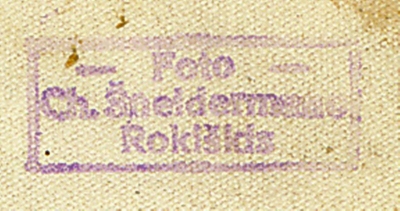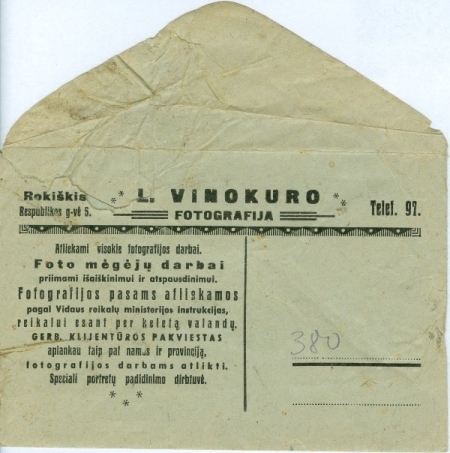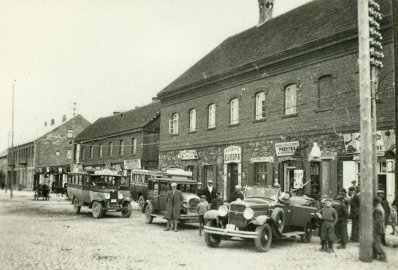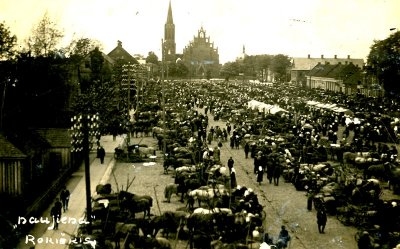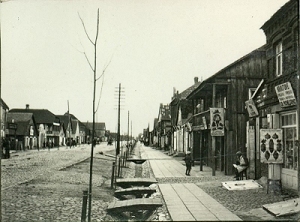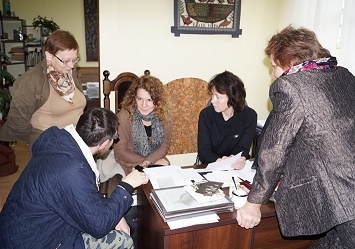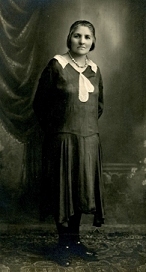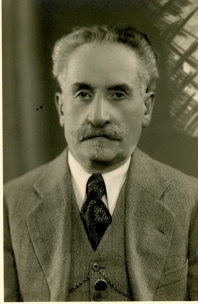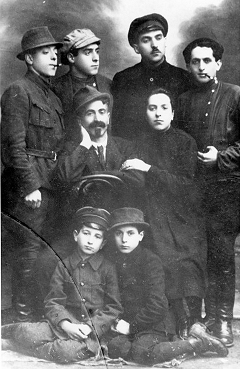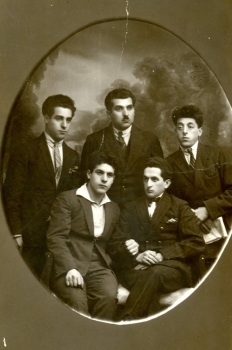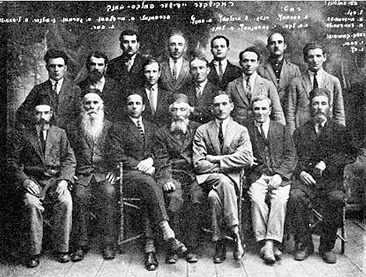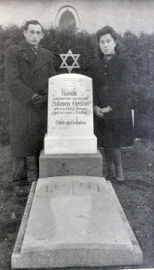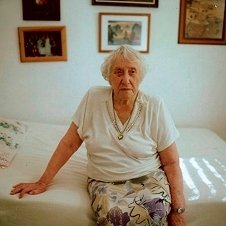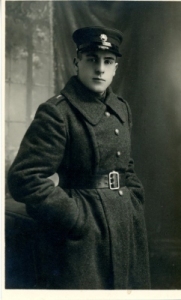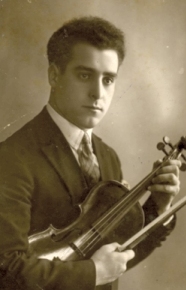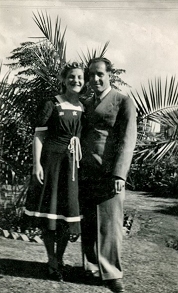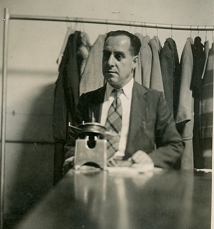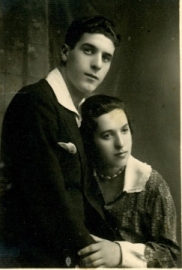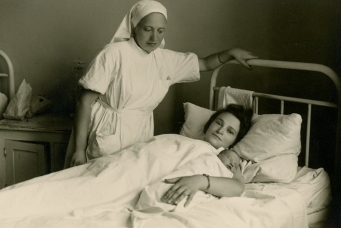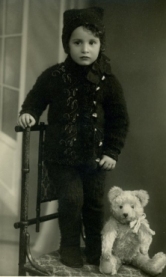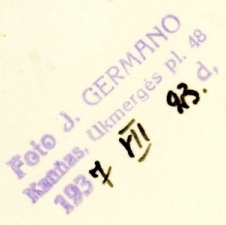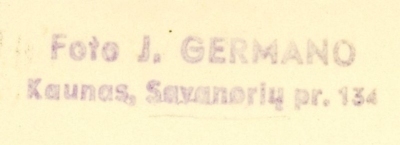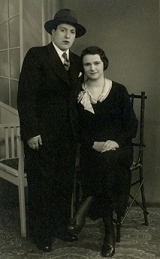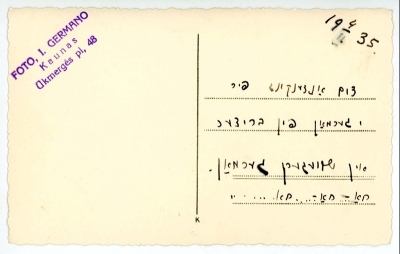
Herman / Germanas Family
[i]
Rokiskis
SIG member Ada Gamsu, of Johannesburg, South Africa, is related to the
prominent Germanas family of professional photographers.
She learned from another relative that in the first half of 2017
the Rokiškis Regional Museum (“RKM” or “museum”) had published an
article about the family.[ii]
The article also noted that a descendant of that family, Sara Mei Herman,
is a professional photographer in Holland.[iii]
The
family’s surname in the 19th Century most likely was Herman.
However, since czarist-era records were written using the Russian
Cyrillic, which replaces the letter “H” with the Cyrillic letter for
“G,” the surname appeared in czarist-era records as “German.”
In independent Lithuania (from 1918), all names were required to be
“lituanized.” In this
case, the Cyrillic surname “German” became “Germanas.”
However, family members living outside of Lithuania have used the
surname of Herman.
Thanks
to Ada Gamsu, the RKM has given its permission to the Rokiskis SIG to
translate the article into English [iv]
and post the English translation on the SIG’s website.
As a result of her efforts and those of Dutch photographer Sarah
Mei Herman, who is the granddaughter of Mordechai Herman, we can
read the English version of the article and see all the fascinating
photos. And a special thank you to Aldona and Phil Shapiro for all
their hard work on this project - Aldona for the translating from the
Lithuanian and Phil for all his research, corrections, and erudite
additions to the endnotes.
From
Photography of the Past: The History of the Germanas Family
DALIA
KIUKIENĖ
Rokiškis
Regional Museum Deputy Director – Chief Custodian of Collections
|
|
|
|
Stamp
of photographer Leiba Vinokuras |
Stamp
of photographer Ch. Shneiderman |
|
|
An envelope from the studio of photographer Leiba Vinokuras |
|
Prior
to the Second World War, the following photographers were known in
Rokiškis: Ch. Shneidermanas,
Leiba Vinokuras, F. Chonas, M. Germanas, and, in Pandėlys,
O. Čadovičius.
|
|||||||||||||||
There
were two photographic studios on Nepriklausomybės aikštė (Independence Square),[v]
namely, “Naujiena” (“Novelty”), at No. 18/5, and
“Renesans” (“Renaissance”), at No. 24. The
“Naujiena” (“Novelty”) studio belonged to Izaokas
Klingmanas (Yitzchak Klingman). He
sold cameras but also demonstrated to customers how to take
photographs, including making samples of their initial efforts to
take pictures. This firm also sold photographs of the town views. Several
other businesses also operated in the hotel Europa building,
namely, shops selling food, groceries, and industrial goods. |
|||||||||||||||
|
|
|||||||||||||||
|
|
|||||||||||||||
|
|
|||||||||||||||
|
In
2014 the Rokiškis Regional Museum published a catalog entitled, Rokiškis
in Photographs 1914-1940. Within
six months all 400 copies were sold and distributed. The
research for and preparation of the publication became the start
of a larger project to collect information about the Rokiškis
region’s photographers. After
the catalog was published, we collected data on two Rokiškis
photographers - M. Germanas and J. Masiulis. Initially,
little was known about the life of Germanas, except that his given
name began with the letter “M.”
That was soon to change. |
|||||||||||||||
|
Museum
collections are publicized not only through print media, but also
through the Internet. The
museum uploaded to its digital library (the “LIMIS” system) a
virtual exhibition of the photographs, which attracted not only
the interest of Lithuanians, but also the interest of foreigners. One
such foreigner was the Dutch professional photographer, Sara Mei
Herman, the granddaughter of Rokiškis photographer Mordechai)
Germanas (1901-1985). In
2015 (the year after the catalog was published) she came to Rokiškis
and brought a collection of family photographs, most of which were
created at the Germanas photo studio.[vii] |
|||||||||||||||
|
|
|||||||||||||||
|
And
thus a project originally intended to bring to light several
photographs in the museum’s collection grew into a study of the
lives of one family of Jewish photographers. During
the course of two years of correspondence, the fragments of the
history of the Germanas family were brought together. It
was learned that two brothers in this family were photographers,
and we guess that one more brother may have been a photographer as
well.
|
|||||||||||||||
|
|
|
|
Solomon
Germanas’s grave in Gauting, Germany. Tonia
Levin and her husband Chanoch Levin are standing next to the grave
(from Tonia Levin's personal album). |
Solomon’s daughter Tonia Germanas Levin. 2016. (from Tonia Levin's personal album). |
|
|
|
|
|
|
|
Mordechai
Germanas in a Lithuanian army uniform around 1922 (from Julian Herman's album). |
Mordechai Germanas. 1927. Rokiškis (from Julian Herman's
album). |
|
Mordechai
(1901-1985) was one of Rokiškis’ most famous photographers. He
lived in there and had his photographic studio at No. 3
Respublikos (formerly, Kamai) street. The
Germanas company was registered in the name of “Reiza Germanienė”
(most probably named either for Mordechai’s mother or his
sister-in-law[x]).
The museum has over 30
photographs bearing stamps of the Germanas studio. The
shape of the company’s stamp changed over the years. Most
of the surviving stamps are oval with these printed letters:
“Fot. Germanas Rokiškis” (“The Photographer Germanas Rokiškis”).
The museum has only a
few samples of rectangular stamps that read “Fotografija GERMANO
Rokiškis” (“Germanas Photography Rokiškis”). |
|
The
surviving photographs show images of students of the Rokiškis “gimnazija,”[xi]
Rokiškis postal employees, the independence monument,[xii]
portraits of people, and moments of holidays and events. Apparently,
he did not stamp all photographs. The
museum has several identical copies of photographs, some of which
were stamped, and others, which were not. Probably
some of the unmarked photographs were made by M. Germanas or other
well-known Rokiškis photographers. |
|
|
|
|
Mordechai
with his wife Bella in South Africa (from Julian Herman's personal album). |
Mordechai in his
clothes-cleaning workshop (Pietermaritzburg, South Africa). (from
Julian Herman's personal album). |
Around
1935, due to the difficult political and economic situation in Lithuania,
Mordechai went to South Africa, where his older brother Itzchak had been
living. At that time South
Africa was believed to be a place of great opportunities. To
avoid military service Mordechai changed the date of his birth on his
documents from 1901 to 1904 with the help of his brother Yakov, who was
living in Switzerland.[xiii]
Mordechai and Itzchak first settled in Durban and later in
Pietermaritzburg. There,
Mordechai worked as a photographer, just as he had when he was in Rokiškis.
Later, Mordechai opened a
clothes-cleaning business. In
addition, he had another hobby – he liked playing the violin. This
is can be seen in surviving photographs. Around
1940 he married Bella. In 1942
they had a daughter Estela; in 1944 their son Julian Herman was born; and
in 1945 their son David Herman came into the world. In
1974 Julian moved to Amsterdam. His
daughter, Sara Mei Herman, continues the family tradition – she is a
Dutch photographic artist. In
2018 the Rokiškis Regional Museum plans to arrange an exhibition of Sarah
Mei Herman’s photographs, which will be dedicated to the memory of the
Germanas family.
|
|
|
|
Yudel and Bella. 1926. Rokiškis (from Julian Herman's
album). |
Yudel’s
wife
Sheina with a newborn girl. 1937. Photographer
J. Germanas, Kaunas (from Julian Herman's album). |
|
|
|
|
|
Merelė, the daughter of
Yudel and Sheina.
1939. Kaunas (from Julian Herman's personal album). |
|
|
|
The
younger son of Germanas family, Yudel (1907?-1944), also worked as a
photographer. Mordechai taught
him the photographic trade. It
is known that they would travel together to shtetls in the Rokiškis
region, stay in people’s homes, and take pictures there. For
a time in 1920 both brothers worked in Kamajai (Kamai, a few kilometers
south of Rokiškis).[xiv]
Later Yudel and his parents
moved to Kaunas. He opened his
own photographic studio there in 1934 and was making photographs until
October 8, 1940. This is
confirmed by the contents of a Kaunas city tax-inspection file which was
opened on December 27, 1938, and closed on October 8, 1940.[xv]
The documents give the
following information about Yudel’s business:
It was located at Savanorių prospect 134, Kaunas; it had
opened in 1934; there were no employees – the owner worked alone; and in
1939 the company had cash income of 2,460 Litas. The
museum has some photos with stamps where another address was indicated -
Ukmergės plentas (road) 48, Kaunas. In
1938 Ukmergės plentas was re-named Savanorių prospect.[xvi]
|
|
|
|
Yudel
married to Sheina (also
known as Sheinele)
Levin, a native of Kupiškis. She
had been orphaned at a young age and grew up in a children’s
shelter in Rokiškis. During
the Second World War Yudel’s family lived in the Kovna ghetto. Their
eight-year-old daughter Merele was murdered in Kovna together with
other Jewish children.[xvii]
Sheina was sent to the
Stutthof concentration camp and survived. Yudel
became a victim of the genocide in 1944. |
|
It
is likely that Itzchak, the second son of the Germanas family, may
also have been a photographer. According
to the memories of relatives, Itzchak went to Durban, South
Africa, in 1926-1927. After
two years, his wife Raisel Levin, together with her daughters
Zelda (born in 1924 in Lithuania) and Sonia (born in 1926 in
Lithuania) arrived at Itzchak’s place in Durban. Their
third daughter, Phyllis, was born in South Africa in 1931. Itzchak
worked as a watchmaker in South Africa. Two
photographs bearing the stamps of I. Germanas (Ukmergės pl.
48) pose a question for us: Was
Itzchak really a photographer? Maybe
the letter "I" was only a printing mistake? Maybe
Itzchak opened a photographic studio in Kaunas earlier than his
brother Yudel? It
could be supposed that Yudel later used his brother’s stamp. Maybe
it’s only Yudel’s trick? The
same as in this photograph which shows Yudel’s wife Sheina and
Yudel’s sister Bella, dressed in a man’s clothes, perhaps
imitating Yudel himself. . |
|
|
|
|
Yudel’s
wife Sheina and his sister Bella imitating Yudel himself – she
is wearing a man’s clothes. 1935. Photographer I. Germanas,
Kaunas (from Julian Herman's personal album). |
|
There
still remains a lot of ambiguity, silence, and uncertainty about
the lives of the people mentioned here. Let’s
hope that the paths of this one described family will, in some
small way, better reveal Jewish life as well as contribute to
research the history of photography. |
=============================================================

